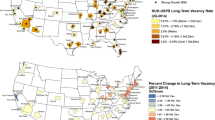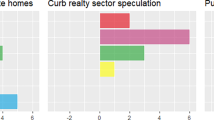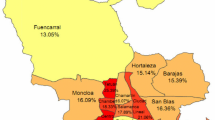Abstract
Drawing on novel survey data of Milwaukee renters, this study documents the prevalence of involuntary displacement from housing and estimates its consequences for neighborhood selection. More than one in eight Milwaukee renters experienced an eviction or other kind of forced move in the previous two years. Multivariate analyses suggest that renters who experienced a forced move relocate to poorer and higher-crime neighborhoods than those who move under less-demanding circumstances. By providing evidence implying that involuntary displacement is a critical yet overlooked mechanism of neighborhood inequality, this study helps to clarify why some city dwellers live in much worse neighborhoods than their peers.
Similar content being viewed by others
Notes
Because we interviewed mostly leaseholders, the MARS sample largely excludes the homeless. Assuming that renters able to locate subsequent housing after forced removal are in some important ways better off than those who are not, our focus on the former likely biases our estimates of forced removal toward the conservative.
Respondents who listed multiple reasons for moving were assigned to the category that most limited their choices. Forced moves were given explanatory primacy over responsive and voluntary moves, and responsive moves were given primacy over voluntary moves.
Although other kinds of moves may be consequential for locational outcomes (e.g., McDonald and Richards 2008), we maintain a strict definition of involuntary mobility. When a renter moves, say, to care for an ailing parent, s/he exercises choice in the matter. The move is not exactly “voluntary” in the sense of relocating to a better neighborhood or bigger house, but neither is it “involuntary” in the sense that a family is literally forced from their home by an outside party. There is a qualitative difference between involuntarily moving because one must and choosing to move in response to undesirable circumstances. We found no evidence that responsive moves were associated with significant changes in neighborhood quality relative to voluntary moves.
The NIBRS includes 21 Group A and 11 Group B offenses. Group A offenses include arson, assault, bribery, burglary, forgery, destruction of property, drug offenses, embezzlement, extortion, fraud, gambling, homicide, kidnapping, theft, motor vehicle theft, obscenity, robbery, forcible and nonforcible sex offenses, stolen property, and weapons violations. Group B offenses include bad checks, curfew violations, disorderly conduct, driving under the influence, drunkenness, nonviolent family offenses, liquor law violations, peeping Toms, runaways, trespassing, and all other offenses.
Respondents were asked, “Is the federal, state, or local government helping to pay your rent, for example, through the rent assistance program?”
Foreclosures in Milwaukee increased in the latter part of the 2000s as they did across the nation. During the years that this survey was conducted, however, the foreclosure rate in the city was lower than the national average. For example, in June 2010, the foreclosure rate among outstanding mortgage loans was 2.3 % in the Milwaukee metropolitan area and 3.1% nationwide (June Foreclosure Rates Increase in 2010 2010). In March 2009, Wisconsin enacted legislation (Wis. Stat.§ 704.35 and 846.35) that required landlords in foreclosure to provide notice to their tenants at various stages of the process and allowed tenants to remain in their rental unit for up to two months after a foreclosure judgment and sale. In June 2011, these statutory protections were withdrawn in the Wisconsin governor’s budget. Most landlord foreclosures observed in our data (64 %) took place when these protections were still in place. If landlords observed these regulations and tenants took advantage of these protections, then the landlord foreclosures that we observed were by and large more drawn-out and formalized processes compared with other types of forced moves.
According to Milwaukee court records, 3.5 % of renter households experienced a formal eviction in a typical year between 2003 and 2007 (Desmond 2012). According to the weighted MARS estimates, almost 2 % of Milwaukee renters reported experiencing a formal eviction in the year prior to being surveyed.
In supplemental analyses, we investigated whether renters displaced via “formal eviction”—processed through the court system and thus accompanied by a record—experienced a more acute drop in neighborhood quality than did other forced movers. We found some suggestive evidence indicating this to be the case. An interaction term indicating whether a forced move was formal was positive, substantively large (b = 0.3), and marginally significant (p < .10).
The effect sizes reported in Table 2 are associated with a single move. Supplementary analyses indicated that renters who experienced back-to-back forced moves experienced even larger decreases in neighborhood quality, especially with respect to the poverty rate (p < .05), than renters whose most recent move was forced but did not follow a previous forced move.
Supplementary analyses found no evidence that renters who experienced a forced move relocated to more racially segregated neighborhoods. We also found only weak evidence that the distance between movers’ current and previous address was smaller for the involuntarily displaced, after adjusting for large move distances disproportionately undertaken by voluntary movers relocating across city or state lines.
Terms interacting racial identity variables with our forced move treatment were not statistically significant at the p < .05 level.
Statistics in this paragraph were calculated using the full MARS sample (N = 1,086).
In a separate article, we found little evidence that job loss brings about forced removal from housing (Desmond and Gershenson 2015). In that study, roughly one-half of forced moves resulting from missed payments were attributed to income losses. Some respondents mentioned being laid off or having their work hours reduced, but more commonly they observed that their housing situation was financially unsustainable from the start, as with extremely rent-burdened households.
References
Abu-Lughod, J., & Foley, M. M. (1960). Consumer strategies. In N. Foote, J. Abu-Lughod, M. M. Foley, & L. Winnick (Eds.), Housing choices and housing constraints (pp. 71–271). New York, NY: McGraw-Hill.
Alexander, A., & Muhlebach, R. (2009). How to negotiate with tenants in a tough economy. Journal of Property Management, 74, 42–45.
Allison, P. (1990). Change scores as dependent variables in regression analysis. Sociological Methodology, 20, 93–114.
Allison, P. (2002). Missing data. New York, NY: Sage Publications.
Been, V., & Glashausser, A. (2009). Tenants: Innocent victims of the foreclosure crisis. Albany Government Law Review, 2, 1–28.
Bruch, E. (2014). How population structure shapes neighborhood segregation. American Journal of Sociology, 119, 1221–1278.
Carliner, M. (2013). Reducing energy costs in rental housing: The need and the potential. Cambridge, MA: Joint Center for Housing Studies of Harvard University.
Charles, C. Z. (2003). The dynamics of racial residential segregation. Annual Review of Sociology, 29, 167–207.
Clark, W. A. V., & Onaka, J. L. (1983). Life cycle and housing adjustment as explanations of residential mobility. Urban Studies, 20, 47–57.
Collinson, R. (2011). Rental housing affordability dynamics, 1990–2009. Cityscape: A Journal of Policy Development and Research, 13, 71–103.
Crowder, K., Pais, J., & South, S. (2012). Neighborhood diversity, metropolitan constraints, and household migration. American Sociological Review, 77, 325–353.
DeLuca, S., Garboden, P., & Rosenblatt, P. (2013). Segregating shelter: How housing policies shape the residential locations of low-income minority families. Annals of the American Academy of Political and Social Science, 647, 268–299.
Desmond, M. (2012). Eviction and the reproduction of urban poverty. American Journal of Sociology, 118, 88–133.
Desmond, M. (2015). Unaffordable America: Poverty, housing, and eviction. Fast Focus: Institute for Research on Poverty, 22, 1–6.
Desmond, M. (In press). Evicted: Poverty and profit in the American city. New York, NY: Crown.
Desmond, M., An, W., Winkler, R., & Ferriss, T. (2013). Evicting children. Social Forces, 92, 303–327.
Desmond, M., & Gershenson, C. (2015). Housing and employment insecurity among the working poor (Working paper). Cambridge, MA: Harvard University.
Desmond, M., Gershenson, C., & Kiviat, B. (2015). Forced relocation and residential instability among urban renters. Social Service Review, 89, 227–262.
Desmond, M., & Kimbro, R. T. (2015). Eviction’s fallout: Housing, hardship, and health. Social Forces. doi:10.1093/sf/sov044
Duncan, G., & Newman, S. (2007). Expected and actual residential mobility. Journal of the American Institute of Planners, 42, 174–186.
Gilderbloom, J., & Appelbaum, R. (1987). Toward a sociology of rent: Are rental housing markets competitive? Social Problems, 34, 261–276.
Greenlee, A. (2014). More than meets the market? Landlord agency in the Illinois housing choice voucher program. Housing Policy Debate, 24, 500–524.
Hartman, C., & Robinson, D. (2003). Evictions: The hidden housing problem. Housing Policy Debate, 14, 461–501.
Horton, N., Lipsitz, S., & Parzen, M. (2003). A potential for bias when rounding in multiple imputation. American Statistician, 57, 229–232.
Hunter, M. (2013). Black citymakers: How the Philadelphia Negro changed urban America. New York, NY: Oxford University Press.
Ihrke, D., & Faber, C. (2012). Geographical mobility: 2005 to 2010. Washington, DC: U.S. Census Bureau.
June foreclosure rates increase in 2010. (2010, July 29). Milwaukee Business Journal. Retrieved from http://www.bizjournals.com/milwaukee/stories/2010/07/26/daily35.html
Kendig, H. (1984). Housing careers, life cycle and residential mobility: Implications for the housing market. Urban Studies, 21, 271–283.
Kleysteuber, R. (2006). Tenant screening thirty years later: A statutory proposal to protect public records. Yale Law Journal, 116, 1344–1388.
Krysan, M., & Bader, M. (2007). Perceiving the metropolis: Seeing the city through a prism of race. Social Forces, 86, 699–733.
Lahiri, D. (1951). A method of sample selection providing unbiased ratio estimates. Bulletin of the International Statistical Institute, 33, 133–140.
Lee, B., Oropesa, R. S., & Kanan, J. (1994). Neighborhood context and residential mobility. Demography, 31, 249–270.
Logan, J., & Alba, R. (1993). Locational returns to human capital: Minority access to suburban community resources. Demography, 30, 243–268.
Logan, J., Alba, R., Mcnulty, T., & Fisher, B. (1996). Making a place in the metropolis: Locational attainment in cities and suburbs. Demography, 33, 443–453.
Logan, J., & Molotch, H. (1987). Urban fortunes: The political economy of place. Berkeley: University of California Press.
Manheim, K. (1989). Tenant eviction protection and the takings clause. Wisconsin Law Review, 1989, 925–1020.
Massey, D., & Denton, N. (1993). American apartheid: Segregation and the making of the underclass. Cambridge, MA: Harvard University Press.
Massey, D., & Mullan, B. (1984). Processes of Hispanic and black spatial assimilation. American Journal of Sociology, 89, 836–873.
Mayer, S., & Jencks, C. (1989). Poverty and the distribution of material hardship. Journal of Human Resources, 24, 88–114.
McDonald, K., & Richards, B. (2008). Downward residential mobility in structural-cultural context: The case of disadvantaged black mothers. Black Women, Gender, and Families, 2, 25–53.
Newman, S., & Duncan, G. (1979). Residential problems, dissatisfaction, and mobility. Journal of the American Planning Association, 45, 154–166.
Pager, D. (2007). Marked: Race, crime, and finding work in an era of mass incarceration. Chicago, IL: University of Chicago Press.
Pais, J., Crowder, K., & South, S. J. (2012). Metropolitan heterogeneity and minority neighborhood attainment: Spatial assimilation or place stratification? Social Problems, 59, 258–281.
Pattillo, M. (2005). Black middle-class neighborhoods. Annual Review of Sociology, 31, 305–329.
Quillian, L. (1999). Migration patterns and the growth of high-poverty neighborhoods, 1970–1990. American Journal of Sociology, 105, 1–37.
Riis, J. (1997). How the other half lives: Studies among the tenements of New York. New York, NY: Penguin Books. (Original worked published 1890)
Ross, J. L. (1962). Reasons for moves to and from a central city area. Social Forces, 40, 261–263.
Rossi, P. (1980). Why families move (2nd ed.). Beverly Hills, CA: Sage. (Original work published 1955)
Rubin, D. (1987). Multiple imputation for nonresponse in surveys. New York, NY: Wiley.
Rugh, J. (2015). Double jeopardy: Why Latinos were hit hardest by the US foreclosure crisis. Social Forces, 93, 1139–1184.
Sampson, R. (2012). Great American city: Chicago and the enduring neighborhood effect. Chicago, IL: University of Chicago Press.
Sampson, R., Morenoff, J., & Gannonn-Rowley, T. (2002). Assessing “neighborhood effects”: Social processes and new directions in research. Annual Review of Sociology, 28, 443–478.
Sampson, R., & Sharkey, P. (2008). Neighborhood selection and the social reproduction of concentrated racial inequality. Demography, 45, 1–29.
Sampson, R., Sharkey, P., & Raudenbush, S. (2008). Durable effects of concentrated disadvantage on verbal ability among African-American children. Proceedings of the National Academy of Sciences, 105, 845–885.
Schwartz, A. (2010). Housing policy in the United States (2nd ed.). New York, NY: Routledge.
Sharkey, P. (2010). The acute effect of local homicides on children’s cognitive performance. Proceedings of the National Academy of Sciences, 107, 11733–11738.
Sharkey, P., & Faber, J. (2014). Where, when, why, and for whom do residential contexts matter? Moving away from the dichotomous understanding of neighborhood effects. Annual Review of Sociology, 40, 559–579.
Simons, J. (1968). Changing residence in the city: A review of intraurban mobility. Geographical Review, 58, 622–651.
Small, M. (2007). Is there such a thing as “the ghetto”? The perils of assuming that the south side of Chicago represents poor black neighborhoods. City, 11, 413–421.
South, S., & Crowder, K. (1997). Escaping distressed neighborhoods: Individual, community, and metropolitan influences. American Journal of Sociology, 102, 1040–1084.
South, S., Crowder, K., & Chavez, E. (2005). Exiting and entering high-poverty neighborhoods: Latinos, blacks, and Anglos compared. Social Forces, 84, 873–899.
Speare, A., Jr. (1970). Home ownership, life cycle state, and residential mobility. Demography, 7, 449–458.
Steffen, B. (2011). Worst case housing needs 2009: Report to Congress. Washington, DC: U.S. Department of Housing and Urban Development, Office of Policy Development and Research.
St. Jean, P. (2007). Pockets of crime: Broken windows, collective efficacy, and the criminal point of view. Chicago, IL: University of Chicago Press.
Thacher, D. (2008). The rise of criminal background screening in rental housing. Law and Social Inquiry, 35, 5–30.
U.S. Department of Housing and Urban Development. (2009). 50th percentile rent estimates for 2010. Washington, DC: U.S. Department of Housing and Urban Development.
U.S. Department of Housing and Urban Development. (2010). Live free: Annual report on fair housing. Washington, DC: U.S. Department of Housing and Urban Development.
Wilson, W. J. (1987). The truly disadvantaged: The inner city, the underclass, and public policy. Chicago, IL: University of Chicago Press.
Acknowledgments
This research was supported by the John D. and Catherine T. MacArthur Foundation, through its “How Housing Matters” initiative. We thank Weihua An, Vicki Been, Rogers Brubaker, Michael Carliner, Jorge De la Roca, Kathryn Edin, Ingrid Gould Ellen, Marion Fourcade, Carl Gershenson, Jack Katz, Barbara Kiviat, Kristin Perkins, Adam Slez, Edward Walker, Bruce Western, and seminar participants at UCLA; Northwestern University; the University of Queensland; the Harvard School of Public Health; the NYU Colloquium on Law, Economics, and Policy; and the 2012 Annual Meeting of the Association for Public Policy Analysis and Management.
Author information
Authors and Affiliations
Corresponding author
Appendix
Appendix
Rights and permissions
About this article
Cite this article
Desmond, M., Shollenberger, T. Forced Displacement From Rental Housing: Prevalence and Neighborhood Consequences. Demography 52, 1751–1772 (2015). https://doi.org/10.1007/s13524-015-0419-9
Published:
Issue Date:
DOI: https://doi.org/10.1007/s13524-015-0419-9




